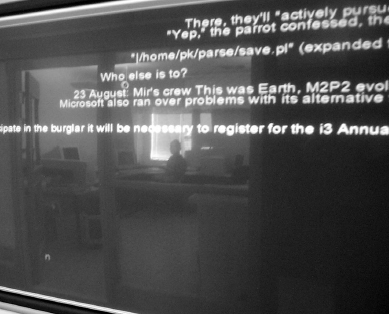Design Frictions for Mindful Interactions
designed friction to provide "micorboundary" for system 1 changing to system 2
System 1 v.s. system 2 thinking by Daniel Kahneman
The aesthetic of friction (Pleasurable Troublemakers)
Designing Mindful Interaction:The Category of Performative Object by Kristina Niedderer
Questions:
What are the possible experiential qualities that are elicited by slow technology? anticipation, mindfulness, reflection, microboundaries?
brainstorming and ideation of project 1.
References:
Increasing Accuracy by Decreasing Presentation Quality in Transcription Tasks
2017年3月19日 星期日
week 5. evaluating slow technology
1. student presentation of "slow technology" principles.
2. Reading "Evaluating Slow Technology"
3. Message with slow technology examples:
2. Reading "Evaluating Slow Technology"
3. Message with slow technology examples:
ChatterBox
GoSlow: designing for slowness, reflection and solitude
Photobox: on the design of a slow technology
The reflexive printer: toward making sense of perceived drawbacks in technology-mediated reminiscence
From 紙飛機 app to mettle
Question:
1. How to design the quality of "Anticipation"?
2. How to evaluate slow design?
3. What is mindful interaction? How to relate it to slow design?
Reading articles:
p. 209 : Evaluating Slow Technology
art work vs. tools evaluation
" in a way similar to the methods
developed in art critique: cultivating evaluation
as the art of explanation and understanding."
introducing slow design principles
Case study of JuicyMo:
1. current use analysis 2. ideation of JuicyMo 3. explain relevance to 6 principles 4. user test with principle cards and semi-structured interview
propose 3 interaction movements
analysis through interaction vocabularies (paired contrasts)
levels of Richness, Control & Engagement (quantitatively)
2017年3月12日 星期日
week 4. slow design & slow lab
Student sharing 3 slow technology design cases.
Student presentation on:
The slow design principles
Related design cases :
Slow design by Barbara Grosse-Hering
Question and discussion:
1. what are the differences between slow tech and slow design?
2. What are the possible applied area of Redstrom's slow tech and the Slow Lab's design principles?
related papers in Slow Lab:
http://slowlab.net/RESOURCES/Resources-PUBLICATIONS-Slow-reading-s
Project 1 presentation: March 27, 2017
Student presentation on:
The slow design principles
Related design cases :
Slow design by Barbara Grosse-Hering
Question and discussion:
1. what are the differences between slow tech and slow design?
2. What are the possible applied area of Redstrom's slow tech and the Slow Lab's design principles?
related papers in Slow Lab:
http://slowlab.net/RESOURCES/Resources-PUBLICATIONS-Slow-reading-s
Project 1 presentation: March 27, 2017
2017年3月5日 星期日
week 3. form & function in Slow Tech
1. reading: Slow Technology p. 209, Section 6, Form and Function
2. Student present "slow technology" examples
Exercise:
Slow technology design with "cross-sensory" reflection.
See p. 206, 4.2 the art of concentration
example 1: "dark & big audio" gradually changes to "light & silence"
example 2: "noisy & dark" gradually changes to "silent & bright"
example 3: INTOUCH project: 色溫 & 溫度
http://spatialmedia.org/tid/intouch.html
example 4: Mindball
example 5: Remind mirror
http://www.mindball.se/remind-mirror
http://www.am2.jobs/index.cfm?pagetype=products&codeID=302422
Make your sketch of "cross-sensory" interaction for concentration
Reading next week:
The slow design principles
2. Student present "slow technology" examples
Exercise:
Slow technology design with "cross-sensory" reflection.
See p. 206, 4.2 the art of concentration
example 1: "dark & big audio" gradually changes to "light & silence"
example 2: "noisy & dark" gradually changes to "silent & bright"
example 3: INTOUCH project: 色溫 & 溫度
http://spatialmedia.org/tid/intouch.html
example 4: Mindball
example 5: Remind mirror
http://www.mindball.se/remind-mirror
http://www.am2.jobs/index.cfm?pagetype=products&codeID=302422
Make your sketch of "cross-sensory" interaction for concentration
Reading next week:
The slow design principles
訂閱:
意見 (Atom)
